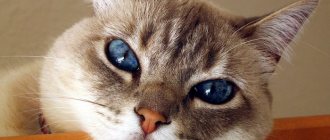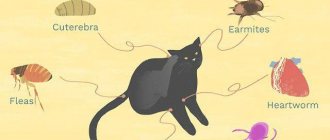Save the article:
It happens that a beloved pet receives a gift from nature of neighbors in the body - worms. Not the most pleasant neighborhood, from which the animal’s body will suffer for a long time if the owner does not undertake deworming. Worms in a cat are a serious disease that depresses all systems of the body: the animal loses weight, eats poorly, and becomes very tired.
Where does such a misfortune come from? Such unkind guests easily enter the body, but leave with reluctance. If you suspect unwanted neighbors, it is better to visit the veterinarian and find out who decided to destroy the cat from the inside.
What are worms?
Answering this question, it would be more correct to say: “not what they are,” but “who are worms”!
Worms (helminths in cats) are endoparasites, worms that live and reproduce in the body. These include nematodes (the most common in cats), tapeworms and flukes. Infection in cats occurs through the eggs of worms or larvae.
Cats have their own species-specific parasites. There is a group of especially dangerous helminths that pose a threat to human health.
What do worms look like in cats?
What do worms look like in kittens and cats?
Helminthiases (diseases caused by worms in cats) are very common. This situation is due to insufficient information among owners about the importance of the problem and, perhaps most importantly, to the large species diversity of cat worms.
Modern parasitology distinguishes 3 types of endoparasites:
- Flukes
(trematodes) are a dangerous, but not very common group of worms in cats. The worms are small in size, rarely exceeding 5 cm in length. Their body shape resembles a willow leaf. On the ventral side there is one or several suckers and in the depth of the sucker there is a mouth. During the development cycle, flukes have permanent hosts (most often fish and shellfish) and intermediate hosts (cats, dogs, other animals, humans). - Tapeworms
(cestodes) - they are very well adapted. Tapeworms in cats are long and flat. The body is in the form of a ribbon consisting of segments (cells) fastened together. Their length can be more than 3 meters! At one end there is a “head” with special suction cups and hooks that allow it to be securely attached to the intestinal mucosa. To reproduce the cestode in cats, the segment is separated from the tail end, releasing it into the environment with feces. Another animal or person swallows this member and also becomes infected with the parasite. - Roundworms
(nematodes) are the most common group of cat helminths. The size of roundworms in cats can vary, from a few millimeters to a meter. Outwardly, they look like a small earthworm, but this type of worm in cats is white or beige.
Types of worms in cats
Now that we have looked at what types of parasites exist, we suggest looking at a table that shows the main types of worms in cats.
| Flatworms | Roundworms | |
| Flukes | Tape | Nematodes |
|
|
|
Localization of helminths
Roundworms in cats
Roundworms are the most common class of endoparasites. The disease caused by infection with roundworms is called nematode disease.
More than 30 types of roundworms are known in cats. The species composition varies greatly depending on the region of residence. Below we will look at the ubiquitous and most dangerous helminths.
Toxocara (roundworm)
Toxocara, also known as roundworms, are common in kittens and adult cats. Toxocara сati is of greatest importance, T. Leonine and T. Canis are less common. In appearance they resemble round noodles of light yellow color. Their length starts from 3 cm and reaches 10 cm.
They are localized in the small intestine and can sometimes take root in the bile ducts and pancreas.
Toxocara worms belong to geohelminths - in this group of parasites, eggs are released into the environment with feces. 1 gram of feces can contain up to 40000
eggs!
Outdoors, under favorable conditions, a larva develops from an egg. A cat can swallow it with water, or as a result of hunting mice and birds, which are carriers of the larvae.
Toxocara is no less dangerous for kittens. Babies can become infected with worms through mother's milk or in utero, through the placenta.
Are roundworms transmitted from cats to humans?
Yes, a person can become infected with roundworms from a cat. The greatest threat is T. Leonine.
Hookworms
Hookworms
Hookworms in cats are dangerous small worms that feed on blood. Capable of causing anemia. Outwardly, they resemble a thread, 5mm -13mm long. Ancylostoma tubaeforme is typical for cats; A. Caninum and A. Braziliense are less common.
The main habitat of adult worms is in the intestines. Larvae can develop not only in the intestines, but also live in the skin.
Hookworms are also classified as geohelminths. But you can become infected with them not only by ingesting the larvae, but also by getting the larvae into the pores of the skin.
Kittens can become infected with hookworm through their mother's milk. Intrauterine route of infection does not occur.
Cat hookworms are also dangerous to humans.
Heartworms
Heartworms in cats are perhaps one of the most dangerous types of roundworms. They also pose a threat to human health! In Russia, dirofilariasis is common. The length of adult helminths living in the heart can reach 30 cm.
Infection with this parasite occurs through the bite of a mosquito, flea, louse, tick, horsefly or any other blood-sucking insect. Larvae - microfilariae - enter the bloodstream. They can only be detected by microscopy of a blood smear.
As they grow, they are localized in the subcutaneous tissue, where they can crawl freely, or in the ventricles of the heart, causing heart failure.
Tapeworms in cats (cestodes)
Tapeworms
Tapeworms are a fairly common guest in the body of cats. Diseases caused by flatworms in cats are called cestodias.
As a rule, they do not cause serious pathologies, but in large quantities they can lead to exhaustion.
All tapeworms are dangerous for the pet owner, but since the development of cestodes occurs with the participation of intermediate hosts, it is not necessary to have a pet at home for infection; it is enough, for example, to eat uncooked river fish.
Cucumber tapeworm in cats
Infection with cucumber tapeworm is called dipylidia in veterinary medicine. The length of the tapeworm is about 70-80 cm.
The development cycle of cucumber tapeworm in cats is complex. The intermediate hosts of parasites are flea larvae and lice eaters, therefore, cats that are neglected to treat fleas are at risk.
Not only a cat, but also a person can become infected, children are especially susceptible. It is important to follow a schedule of preventative flea treatments for your pet.
Wide tape on a cat
Broad tapeworm
Broad tapeworm is one of the largest worms in cats. Its size in the body of cats reaches 1-2 meters. In the human intestine it can grow up to 10 meters. The disease is called diphyllobothriasis.
A cat can become infected by consuming freshwater raw fish. Scalding and freezing does not kill the parasite. The only effective way to protect river fish is boiling for 10-20 minutes.
Echinococcus
Echinococcus in cats is a dangerous parasite with a complex development cycle. The cat is the definitive host and is in the sexually mature stage. Releases eggs into the environment. They infect intermediate hosts (herbivores, pigs and humans). As the parasite develops, dangerous echinococcal blisters appear.
Trematodes (opistarchosis and liver fluke) in cats
These are small flatworms - flukes. They are localized in the intestines, gall bladder and liver. For cats, the most important parasite is the cat fluke (Opisthorchis felineus). They pose a serious danger to humans and cause the disease opistarchosis.
Liver fluke is rare in cats.
Infection occurs through intermediate hosts - mollusks and freshwater fish. People and animals living in the Volga, Dnieper and Don river basins are at risk.
Danger to humans
Prevention of infection with cestodes is important to protect not only domestic animals, but also the person himself. It is for this reason that it is necessary to combat mice and rats, as well as blood-sucking ectoparasites. How dangerous are cat “cestodes” for their owners? Here everything depends solely on the type of worms, as well as on the human condition.
In particular, there are isolated reports about the possibility of “picking up” parasites from the genus Taenia. The risk of infection is relatively low, and diseases caused by these cestodes are not very common in our country, but still the probability is different from zero.
The eggs of all cysticerci develop successfully when they enter the human body . To remove cysts or larvae that have not yet had time to “pupate” in the internal organs, it is necessary to resort to serious chemotherapy or (more often) surgical intervention.
Finally, long-term use of antihelminthic drugs in prophylactic doses will be required. This is necessary to completely prevent the possibility of re-infection.
What about the common Dipylidium caninum? It is reported that there is also a possibility of infection with it. But this happens more often in the case of small children who accidentally eat an infected flea. But in this case, parents do not need to panic: in the human body this parasite feels “out of place”, almost does not grow, and is easily destroyed by praziquantel.
Symptoms of worms in cats
Signs of worms in cats and kittens are very diverse. Helminthiasis is a widespread disease that, as a rule, manifests itself only in the later stages, when the number of worms reaches unimaginable limits. Symptoms are mainly related to the location of the parasites.
Gastrointestinal helminths are characterized by periodic digestive disorders. It manifests itself as nausea, vomiting, diarrhea or, conversely, constipation and lack of appetite. There may be streaks of blood in the feces.
Infected cats have dull hair that falls out easily, a sagging belly, itching in the anal area and, if the liver is affected, yellow mucous membranes.
When cats are infected with lung and heartworms, the symptoms are specific: cough, anemia, heavy abdominal breathing, unattractive appearance.
In all cases, dermatitis may develop, bald patches and a rash may form. In severe cases, against the background of helminthic infestation, cats may develop toxicosis and neurological diseases. Kittens and young pets will have growth retardation.
Having discovered such symptoms, the owner is faced with questions: “What to do if a cat has worms, and what danger threatens when worms are found in a cat’s feces?”
Diagnosis
Diagnosis is based on the detection of fragments of parasite bodies in feces . In addition, diagnosis is possible based on the detection of eggs in stool analysis. In the cucumber tapeworm, the segments resemble white cucumber seeds; in other types of cestodes, the body segments are more similar in shape to small rectangles.
Note that the segments have a shape that is sufficiently characteristic for making a diagnosis and clarifying the type of parasite, exclusively in a fresh state. When dry, they wrinkle, which complicates the “identification” process.
In these cases, dried tapeworm segments can be rehydrated in saline. Simply put, the dried segment is placed in a warm liquid, after which it is saturated with moisture and straightens out again, becoming a good material for microscopic examination.
Why is segment research so important? The fact is that in many cestodes the eggs are released exclusively by segments that have entered the external environment. To put it simply, there are either no eggs in the feces, or there are so few eggs there that examining the feces will not yield anything in any case.
Why are worms dangerous for cats?
A cat's health is at risk when there are high numbers of worms in the body. As we have already understood, the symptoms when cats are infected with worms are very non-specific. They can also be confused with bacterial, viral and non-communicable diseases. Regular prevention is important to prevent critical disorders.
• Can a cat, cat or kitten die from worms?
Worms in cats and kittens can cause death if the infestation is severe, but, as a rule, owners manage to notice the symptoms and cure the animal.
How to find out that a cat has worms if their eggs are not found in the feces
Lungworms are manifested by a cough, but coughing can be a symptom of other diseases. Based on this, the only real way to protect an animal is to prevent helminthic infestation.
This procedure is absolutely painless, and now there are pills that are taken once and not necessarily on an empty stomach. Fleas are carriers of some types of worms, so if you find fleas on a cat, there is a high probability that there are also worms.
To rid a cat of parasites, you need to know what type of worms the animal is infected with. For example, a drug can be effective against roundworms and harmless against tapeworms. It is advisable to take broad-spectrum drugs under the supervision of a veterinarian.
Treatment of worms in cats
Treatment of worms in cats is quite effective. There are several active ingredients that, in the right combination in a deworming medicine for cats, can affect all classes of parasites. They are called broad-spectrum anthelmintics.
The active ingredients of deworming products for cats include the following substances and their combinations.
Old, but still effective:
- Pyrantel pamoate / Embonate
- Paraziquantel
- Fenbendazole
- Ivermectin
More modern and safer:
- Moxidectin
- Oxibendazole
The newest substances that rarely show side effects and affect almost all worms:
- Milbemycin oxime
- Niclosamide
- Emodepside
Treatment is always carried out in a course. This is 2 or 3 times the use of drugs, with an interval of 7-14 days. Sometimes higher doses are required.
There are several forms of anthelmintics:
- Deworming drops for cats
- Suspensions
- Pills
- Injections
Anti-worm suspensions for cats
Suspension Parasiticide
Suspensions for deworming are one of the most convenient and popular forms of anthelmintic drugs. Their advantage is the ability to accurately dose according to the pet’s weight and ease of feeding. Anti-worm suspensions can be given to kittens and adult cats.
Some of the modern, safe and effective drugs for the treatment and prevention of helminthiases:
- Anti-worm suspension “Parasicide” for cats
- “Clandestine” is a suspension for cats against worms.
How to give a suspension against worms
Giving your cat a deworming suspension is quite simple. The required amount is drawn into a syringe (usually included) and injected onto the root of the tongue, or mixed with food.
Deworming tablets
Deworming tablets for cats are a fairly modern form. Many anthelmintics are available in tablets. They almost always add meat flavorings for better eating.
How to give a cat a deworming tablet
Cats willingly eat tasty deworming tablets on their own. For bitter drugs, it is most convenient to use a device - a tablet dispenser (piller). You can put the tablet on the tongue and make sure that the cat swallows it. For picky cats, you can crush the tablet into powder and mix it with water or a treat.
Injections for worms
Injections against worms are very effective, since the drug immediately enters the bloodstream, which feeds most parasites. Typically used only by veterinarians in a clinical setting. Their use requires careful dosing, and an overdose will undoubtedly cause side effects.
Drops on the withers for worms
Drops on the withers for cats against worms are a new class of drugs. They usually work not only against endoparasites, but also against fleas and ticks. The active substance is absorbed into the blood through the skin, so it is very important to follow the technique of applying drops.
Folk remedies for worms for cats
The effectiveness of folk remedies against worms is questionable. They can help in the first stages of infection, but are completely useless with moderate and severe infestation. Traditional anthelmintics are not safe. Dosing herbal remedies is difficult, and overdose easily causes poisoning. Allergic reactions often occur. Among herbs, wormwood tincture and tansy decoction are recommended.
Prevention of worms in cats
Prevention of infection with worms in cats is perhaps the most important means of helping to preserve the health of the pet and its owner.
To do this, it is necessary to prevent healthy animals from coming into contact with untreated ones, feed them with ready-made or heat-treated food, keep shoes and outdoor clothes in a closet to which the cat does not have access, and keep the litter box clean.
Particular attention is paid to preventive treatment schemes using veterinary anthelmintic drugs:
- For cats that do not go outside and do not have contact with other animals, treatment is recommended 2 times a year, or testing feces for worm eggs.
- For cats that periodically walk outside under the control of the owner and communicate with other treated animals, prophylaxis is carried out 3 times a year.
- Cats that hunt mice, often walk outside, or interact closely with untreated animals are recommended to be treated 4 or more times a year.
References
1. Khojayan, A.B., Kozlov, S.S., Golubeva, M.V. Medical parasitology and parasitic diseases. Protozoa and helminthiasis. Tutorial. - M.: GEOTAR-Media, 2021. - 448 p.
2. Tokmalaev, A.K., Kozhevnikova, G.M. Clinical parasitology. Protozoa and helminthiases. Guide for doctors. - M.: MIA, 2021. - 392 p.
3. Shreiner, E.V. Helminth infections in pediatric clinical practice: issues of diagnosis, therapy, prevention. RMJ. Mother and Child, 2013. - V. 14.











